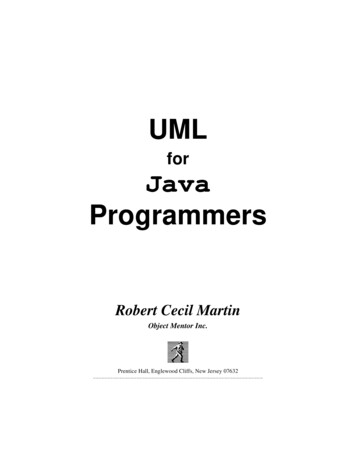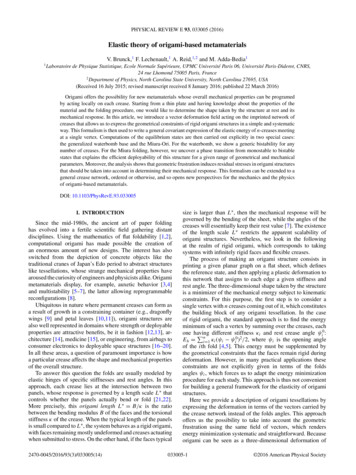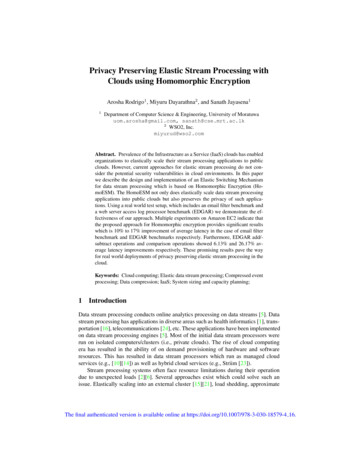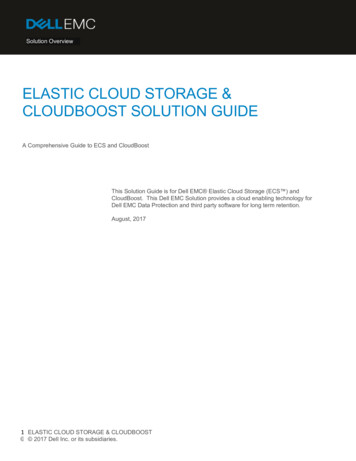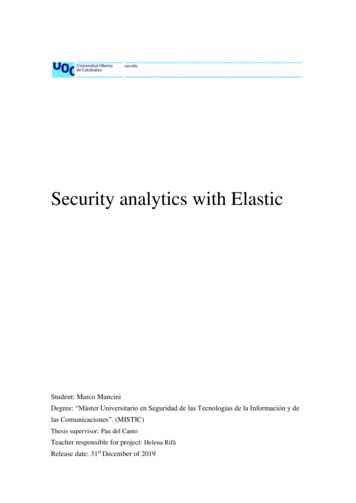
Transcription
Security analytics with ElasticStudent: Marco ManciniDegree: “Máster Universitario en Seguridad de las Tecnologías de la Información y delas Comunicaciones”. (MISTIC)Thesis supervisor: Pau del CantoTeacher responsible for project: Helena RifàRelease date: 31st December of 2019
Security analytics with Elastic by Marco Mancini is licensed under a Creative CommonsAttribution 4.0 International License.
TFM propuesto por ANCERT El objetivo del proyecto es utilizar las nuevasfuncionalidades de Elastic que permiten un análisis más sencillo de fuentes de informaciónque en un entorno empresarial pueden aportar información de seguridad: DNS, Netflow, logsde autenticación y auditoria. También es de interés para el proyecto la integración conherramientas SIEM (ArcSight, QRadar.) y el uso del módulo de machine learning para ladetección de anomalías.Datasheet for ProjectProject titleSecurity analytics with ElasticAuthor’s nameMarco ManciniConsultant’s namePau del CantoPRA nameHelena RifàDegreeMáster Universitario en Seguridad de las Tecnologías de laInformación y de las ComunicacionesLanguageEnglishKeywordsData analysis, Logstash, Elasticsearch, Kibana, SIEM, Elastic, Beats,Security Analysis, Incident Response.ProblemThere is little bibliography that is both up to date and with a focus on security in theenterprise for the Elastic stack.This project aims to synthetize the new developments in the Elastic stack andcontextualize them using practical examples that could be replicated by other analysts.ObjectivesThe objectives of this project are: Analyse the current state of the art for the Elastic stack project in regard to its use forsecurity analysis.Building a laboratory with both a functioning Elastic stack and live endpoints. Todemonstrate current capabilities within different scenarios.The following scenarios will be covered to demonstrate which logs and functionalitiesof the Elastic stack can be useful for them:
Ubuntu machine being infected by crypto miner. Ubuntu Server running apache being compromised through an exploit.Finally, I hope to produce an evaluation of the old and new modules of the Elasticstack when applied to an incident response context. Which include the SIEM, MachineLearning, watchers, dashboards, Timelion and Graph.Resources usedItemCost estimationOfficial Elastic documentationOpen sourceO’Really Documentation on Elastic Stack50-200 EurosElasticsearch Platinum license (Trial)Support licenses (Ubuntu, Osquery, Apache)32 Gb i7 ServerFreeOpen Source800 Euros
Contents1. Introduction. 91.1.Statement of work . 91.2.Thesis’ structure . 92. Methodology . 103. State of the art . 113.1. SIEM space. 113.2. Analysis of Security in ELK . 123.3. Dataset/Threat Hunting Labs in ELK. 134. Elastic Stack . 154.1. Beats. 154.2. Logstash . 174.3. Elasticsearch . 174.4. Kibana . 175. Scenarios Laboratory . 185.1. Introduction . 185.2. Summary of datasets . 185.3. Mitre att&ck analysis . 196. Ubuntu server scenario . 206.1. Introduction . 206.2. Dataset used. 216.3. Preparation . 216.4. Red Team actions . 226.4.1 Reconnaissance . 226.4.2 Intrusion/Exploitation . 236.4.3 Exfiltration. 246.5. Blue Team Analysis . 246.5.1 Scanner Detection. Scanner user agent (nmap) . 256.5.2 Scanner Detection. High volume of ports accessed . 266.5.3 Scanner Detection. Failed access to closed ports. 28
6.5.4 Vulnerability. Errors in applications . 286.5.5 Shell Detection. Commands spawned from service . 296.5.6 Shell Detection. Command and Control beacon . 316.5.7 Exfil. Important files being accessed by an unknown process.326.6. Conclusion . 337. Ubuntu Honeypot server scenario. 337.1. Introduction . 337.1.1 Objective. 347.1.2 Dataset used . 347.2. Information collected . 347.3. Threat Intelligence . 357.3.1 Hash . 367.3.2 Network artifacts . 377.3.3 Tactics techniques and procedures . 377.4. Conclusion . 388. Ubuntu Cryptominer server scenario . 398.1. Introduction . 398.1.1 Shellbot analysis . 398.1.2 Dataset used . 448.2. Preparation . 448.2.1 Lab Environment . 458.3. Malware actions. 478.3.1 Initial Access . 478.3.2 Execution . 478.3.3 Persistence . 498.3.4 Defence Evasion . 508.3.5 Credential Access . 538.3.6 Discovery . 538.3.7 Lateral Movement . 53
8.3.8 Command and Control . 548.3.9 Impact . 558.4. Blue Team Analysis . 558.4.1 Scanner Detection. High volume of IPs on port 22 accessedby one host. 568.4.2 SSH brute force scanner Detection. High number of failedlogins from IP . 588.4.3 Suspicious command executed on CLI . 588.4.4 Persistence review. Unique app added to cron job. . 598.4.5 Scripts executed from hidden folder. . 608.4.6 Encoded commands pipe out to bash . 618.4.7 System discover commands . 628.4.8 Connection to crypto mining network. . 638.4.9 Spike in CPU usage by single unknown process. . 648.5. Conclusion . 658.5.1 Shellbot Adama searches Dashboard . 669. Final Conclusions . 67Appendix . I1.References . II2.List of illustrations . III3.List of tables .V4.List of Code .V5.Architecture of the laboratory . VI5.1.Collection configuration . VI5.2.Dockerized ELK . VI5.2.1 Activate trial for platinum license. .VIII5.3.Script to Install agents . IX5.4.Installing agents . IX5.4.1 Setup Dashboards from Agents . IX5.4.2 Set Index patterns from Kibana . XI5.4.3 Metricbeat .XIII
5.4.4 Packetbeat . XIV5.4.5 Auditbeat . XV5.4.6 Osquery. XVII5.4.7 Filebeat . XVIII5.5.Issues encountered . XIX5.6.Snapshots and Backup. XXI5.6.1 Snapshot . XXI5.6.2 Backup . XXIII6.Import/Export scenarios. . XXVI6.1.Export scenario . XXVI6.2.Import scenario . XXVI
1. IntroductionCybersecurity is an industry with the collective objective to make the digitalinfrastructure that supports the world as robust and secure and possible.One relatively recent development in this space has been the efforts to share dataabout attacks and malware in ways that are easy to share and analyses. This thesis will,hopefully, help the cybersecurity community in this endeavour.Some projects have open datasets with documented threat hunting analysis.However, there is no project with a focus on the Linux platform. Therefore, this thesis isstate of the art in the Linux space at the time of its writing.1.1. Statement of workThe objectives of this project are: Analyse the current state of the art for the Elastic stack project in regardto its use for security analysis. Build a laboratory with both a functioning Elastic stack and liveendpoints to demonstrate current capabilities within different scenarios. The following scenarios are covered, then analysed with a threat huntingmethodology: An Ubuntu Server, running vulnerable service compromised using anexploit A honeypot, to collect malware sample of crypto miners A simulated corporate network, being infected by a crypto-miner worm1.2. Thesis’ structureThe chapter structure of this thesis is the following: Introduction: This chapter contains a description of the state of the art forQ4 2019 and the methodology.9
Elastic Stack: This chapter contains an introduction to the Elastic stackand its components. Scenarios laboratory: This chapter contains 2 attack experiments and onedata source from a honeypot. Final Conclusions: This chapter contains the summary and results of thisproject. The annexe contains the following chapters: Architecture of the laboratory: This chapter has a guide for theinstallation process of the laboratory. This laboratory replicates an Elasticdeployment and a client machine. Import / Export scenarios: This chapter contains how to import/export thedatasets generated in the threat simulation experiments2. MethodologyWe analyse the current state of the art for the Elastic stack project in regard to itsuse for security analysis. This analysis provides the context for the practical part of thiswork.We built a laboratory with both a functioning Elastic stack and live endpoints.The experiments describe how to replicate the scenario and include the raw data todownload.In the different scenarios, we explain which data to use, how to replicate theattacks, and how to analyse a malware piece.Each scenario has an explanation of how to use the Elastic stack to analyse theseincidents. We use a methodology based on the mitre att&ck classification. With whichwe use to contextualize the attacker and the defender perspective.10
3. State of the art3.1. SIEM spaceGartner1 list 43 products belonging in the SIEM space. Some of the names onthat list are Splunk, LogRhythm, McAfee ESM, QRadar and the Elastic stack that weare using.The SIEM space covers several components that are integral to running aneffective Security Operation. It manages the ingestion, normalization, correlation andalerting of security alerts.State of the art right now would be solutions like Splunk, that have an easy to useingestion capability and an active community. But during the last quarter of 2019, theElastic Stack has implemented or announced 2 improvements that have placed them inan exciting position in the market. The SIEM component: This Kibana feature integrates alerting, anomalydetection2 and machine learning jobs that help uncover anomalous behaviour. Endgame integration: The EDR tool from Endgame 3 integrated with theElastic Stack.However, this thesis will propose a process to investigate datasets of attacks andlearn and share threat hunting investigations.However, this thesis proposes a process to investigate the datasets of attacks andlearn and share threat hunting investigations.In this space, it is essential to have a robust collection of logs. If we focus onopen source products, the agents (Auditbeat and Packetbeat especially) in the ElasticStack are state of the art, alongside Osquery, as they have the flexibility and potential tobe used to generate security-relevant logs4 to be ingested in an analytics ecurity-information-event-management2 https://www.elastic.co/products/siem and c-siem3 ing-threats-on-linux-hosts-with-auditbeat and analyticswith-windows-event-logs11
The Elastic Stack is a platform that is easy to deploy and open source. Making itthe perfect candidate to build on-demand personal environments to analyse securityevents. Splunk can be accessed which a trial, but it lacks the flexibility of being able tobe deployed in a docker environment on an open-source license.The following projects are currently state of the art in terms of SIEM-likedeployments for single user laboratories. They all based on the Elastic Stack. HELK5 SOF-ELK63.2. Analysis of Security in ELKThis chapter is concerned with the ecosystem of dashboards, visualizations andsearches that the Elastic community generates in regard to the Security space.A key point in security analysis is to be able to talk a common language to beable to share detection and build a correlation between log sources. The Elastic stacksolves this problem with the Elastic Common Schema, ECS7. A dictionary for fields tostandardize fields like source IPs, domains and file hashes.ECS has made it easy to share detections and investigations to detect attackers.Elastic has released Dashboards and visualizations to help make use of the Beats. Allthe agents used in this project, including Osquery, have out of the boxvisualizations/dashboards8.Moreover, there are community-led projects with detections, dashboards andvisualizations. For this project, we use the Adama9 repository, which contains a lot ofElastic Common Schema searches.There is also the Sigma10 project. This open-source project is an open rulesetthat translates into several SIEM formats. It's effortless to translate into searches and5https://github.com/Cyb3rWard0g/HELK6 https://github.com/philhagen/sof-elk7 html, rrent/view-kibana-dashboards.html and rent/view-kibana-dashboards.html9 https://github.com/randomuserid/Adama10 https://github.com/Neo23x0/sigma12
alerts for Watcher 11 (the alerting component of the Elastic stack) or ElastAlert 12 (anopen-source project to alert on Elasticsearch queries)The company SocPRIME13 offers paid community security rulesets that translateinto all the major SIEM appliances, including the Elastic stack.The following projects have visualizations, dashboards and other objects forthreat hunting. But their focus is forensics. Kibana ForensicDashboards14 HELK15 SOF-ELK16A special mention is an open-source repository for threat hunting queries,dashboards and playbooks for the proprietary SIEM from Microsoft, Azure Sentinel.This repository is the host of exciting articles in which they propose methodologies foranalysis based on the Mitre att&ck matrix. They are focused on Windows and cloudinfrastructures3.3. Dataset
able to share detection and build a correlation between log sources. The Elastic stack solves this problem with the Elastic Common Schema, ECS7. A dictionary for fields to standardize fields like source IPs, domains and file hashes. ECS has

